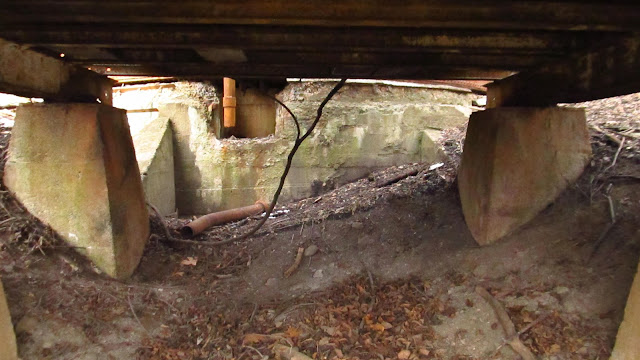Yesterday we made a trip over to Washington County to check out some locations. While we were in the area, we crossed the river into Allegheny County to check out some mine features I had noticed along the road. The mine was the Tucker Mine which turned out to be a captive mine of the Liggett Spring and Axle Company, whose factory was located right at the mine's entrance.
 |
Tucker Mine noted on the map. The entrance is on the factory side and crosses underneath the road into the mine. The shaft on the map is an air shaft that still contains its fan. |
Naturally the next thing to do was look up Liggett Spring and Axle. Thankfully, the website Lost Monongahela had done a full history of the company a few years ago. The following is a simple cut and paste from that website. This account was written by Tom Headley and verifies a lot of the information we read on the walls (literally) of an old pump house on the property. That's coming up in a minute.
In 1903 the Liggett Spring & Axle Company moved from Pittsburgh’s North Side and built a factory to manufacture buggy springs and axles. To provide raw material for this plant, the owners also constructed an adjoining foundry to supply castings. Business boomed during World War I from the manufacture of springs and axles for army vehicles. At this time the plant was reported to be the largest spring factory in the country. In 1916 the company built two rows of identical brick houses (still standing) to house their employees which became known as Axleton. With the shift to automobiles, the axle plant was separated from the foundry and began doing business as the Coshocton Iron Works engaged in the manufacture of parts for stoker furnaces. This plant later combined with others to form the Combustion Engineering Company which continued to operate the plant until the 1980’s. (From the History of Forward Township, Tom Headley).
So that is as in depth as I'm getting into the history of this place. I would certainly recommend perusing the Lost Monongahela website. It's very interesting and does a great job of covering the history around Monongahela.
As I mentioned earlier, there is a nice old pump house at this site as well as some interesting huge water tanks. Our interpretation is the water was pumped from the river and sent to the storage tanks. The mill was then gravity fed from the tanks allowing a consistent water pressure. Again, that's our theory and it could be completely wrong.
 |
This is looking inside the entrance to the Tucker Mine. |
 |
There's still track but who knows how deep this mud is. |
 |
Looking up toward the road. The mine entrance is below the road toward the center of the photo. The shaft noted on the map, as well as an additional shaft, are visible on the other side of the road. |
 |
One of the shafts. |
 |
This hopper is just sitting along the road. Perhaps on top of a third shaft. |
 |
Looking down into the one shaft. The bottom tapered back and appeared to be open. |
 |
Fan in the air shaft. |
 |
The ground collapsed behind the air shaft leaving this big hole. |
 |
Side of the air shaft. |
 |
Heading over to the water tanks. |
 |
Underneath the first tank. |
 |
Valves. |
 |
Inside the water tank. There's a big cut out in the side. |
 |
The first tank is supported on standard gauge rail. |
 |
Side of the tank. |
 |
A closer look at what supports this tank. |
 |
There is some faint writing on the side of the tank. Ghost lettering from old paint. |
 |
Some more ghost lettering. It definitely left us with more questions than answers. |
 |
Valves. |
 |
At this point we still had no idea what these tanks were for. Still, we only have a working theory. Next up is the pump house and things start falling into place. |
 |
We were pretty confident the power had been shut off long ago. |
 |
And now the writing on the wall. |
 |
Whoever started this was an absolute genius. 12/31/56 was a cold day. Lest we forget. Todd was cleaning slop on New Years Eve. |
 |
Winch that lowered things in the pit below it. |
 |
More writing. This time with hand prints. The pump house was still functioning in November 1977. |
 |
A memorial to Chas E. Dexter. |
 |
Pa. Flood June 24, 1972. Record cold July 6, 1972 only 47 degrees. Also Liggett sold on November 13, 1972. |
 |
Liggett had a fire 3/24/72 and 7 inches of snow. |
 |
More hand prints and hangers for 4.6 and 5.0 tools. |
 |
Looking out at the river. |
 |
Spring buds on the trees. |
 |
Looking down the pits. |
 |
Brickwork and winch. |
 |
Side of the pump house. |
 |
Piers from the river tipple at Catsburg. |
 |
River side of the pump house. This shows you how deep those pits go. |
 |
Looking across at the miners houses in Catsburg. |



















I check in here every Sunday evening to see where you went over the weekend.
ReplyDeleteAwesome! Thanks John!
DeleteI WORKED AT LIGGETT FOR 9 YEARS. AND 1 YEAR AFTER FIRE. DON NEVILLE.
ReplyDelete